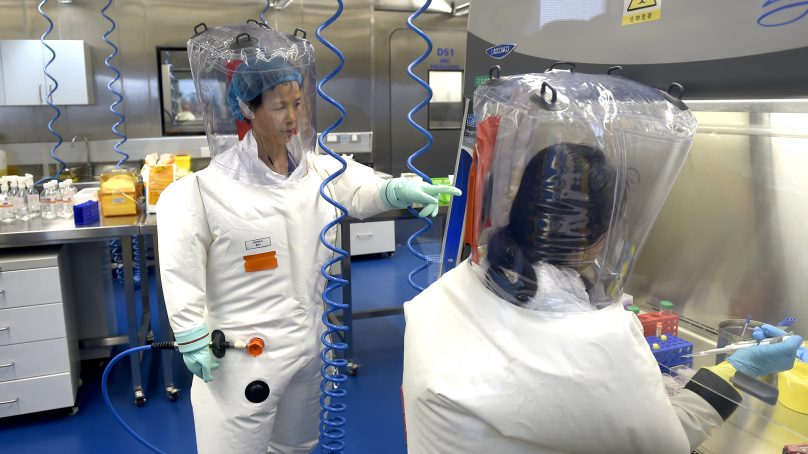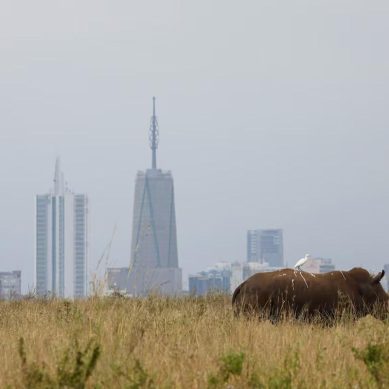
Some scientists who favour the natural origin theory have argued that the Wuhan lab would have only employed familiar backbones in the published literature and swapped out spike proteins.
Because these backbones in the published literature are too genetically dissimilar to have generated SARS-CoV-2, they have argued the DEFUSE proposal is irrelevant to the pandemic.
However, more candid early drafts of the grant show the researchers planned to test engineered spike proteins in these familiar backbones as an initial test that would help them prioritize genomes for the next step: the generation of synthetic viruses in six pieces.
The spike proteins identified by the group this way to have “pre-epidemic potential” would be employed in the next step, the generation of “full genome length viable viruses.”
The documents show that the scientists behind DEFUSE proposed a strategy to stitch SARS-related viral genomes together using six pieces.
They planned to assemble full-length synthetic viruses. These viruses were to be assembled from consensus sequences – sequences that summarise the most common base pairs among a group of closely related viruses.
These viruses could have up to a 5 per cent nucleotide variation from one another. RaTG13, one of SARS-CoV-2’s closest cousin viruses, which was sequenced by the Wuhan Institute of Virology, is 4% different than SARS-CoV-2.
“We will identify the best consensus candidate and synthesise the genome using commercial vendors (e.g BioBasic, etc), as six contiguous cDNA pieces linked by unique restriction endonuclease sites that do not disturb the coding sequence, but allow for full length genome assembly,” the grant states.
The documents show they anticipated synthesising viruses to be cheap. The researchers planned to infect mice with humanised lung cells with these full-length synthetic viruses.
This language in the newly revealed documents echoes a 2022 analysis that uncovered a pattern of two restriction enzymes, BsmBI and BasI, that segmented the SARS-CoV-2 viral genome into six even pieces. The scientists estimated the likelihood of observing this pattern of evenly spaced segments in nature to be highly improbable.
At the time, it was dismissed by Andersen as “kindergarten molecular biology.”
“Many virologists said that our analysis was flawed, claiming that the aim must have been to replace the entire spike … or that similar patterns can be found in virtually any coronavirus genome,” said University of Wuerzburg molecular immunologist Valentin Bruttel, a coauthor of that analysis.
Bruttel continued: “Exactly as we had postulated, they planned to use six segments to assemble synthetic viruses.” The newly revealed documents also include an order from New England Biolabs for BsmBI, one of these key restriction enzymes.
They also planned to buy other unspecified restriction enzymes. New England Biolabs also sells BsaI restriction enzymes, in addition to hundreds of others.
In the ordering of the documents obtained by US Right to Know, this budget table appears right after an email in which Tonie Rocke, a US Geological Survey collaborator on the project, says her budget is attached.
While Rocke was set to collaborate with Baric, it’s not clear that she was central to this genetic engineering work. Still, some scientists say this finding is akin to a “smoking gun” in favour of the lab hypothesis. But the finding is likely to stir debate.
Some of the same restriction enzyme sites identified as possible signals in SARS-CoV-2 have been identified in viruses closely related to SARS-CoV-2 in nature, indicating they could have resulted from recombination, not engineering.
Newly available notes from calls related to the DEFUSE proposal show that the research group was interested in SARS-related coronaviruses that resemble SARS-CoV-2 in a pivotal portion of the viral genome that attaches to human cells – the receptor binding domain.
Baric planned to screen for receptor-binding domains with epidemic potential by looking for cleavage sites and receptor-binding domains adept at attaching to human ACE2 receptors.
In addition to the furin cleavage site, the almost immediate ability of SARS-CoV-2 to spread among humans without having to evolve much – the fact it was “well adapted” – has been a red flag for a possible lab origin since the early months of the pandemic.
The notes also show that Baric engineered spike proteins that do not appear in the public scientific literature and that this work may have already been underway as the proposal was submitted to DARPA.
“RB [Ralph Baric] has already generated SARS-like chimeras w/ RBD [receptor binding domain] from group of bat viruses called 293 (for S1) which is 20 per cent different than epidemic strains, and S2 region from HK3 which is 20 per cent diff,” the notes read, apparently referring to engineered spike proteins generated from two different strains of bat viruses.
While HKU3 bat viruses are known, the reference to “bat viruses called 293” is ambiguous, and does not appear to refer to any public group of viruses. Many of the viruses sampled by the Wuhan lab were not evaluated for transmissibility or pathogenicity at the time the grant proposal was submitted. Their genomes may not be public.
“The Wuhan Institute of Virology team will continue to collect biodiversity surveys from SARSr-CoV viruses of bat caves across S. China,” the documents read.
The documents continued: “They have large, but incomplete collections of SARSr-CoVs sequences, most of which have not been evaluated for pre-epidemic potential.”
Earlier versions of the grant proposal identify Wuhan Institute of Virology Senior Scientist Shi Zhengli’s lab as conducting experimental tests, though this was eventually concealed from DARPA. The documents show the research group had a hotspot for sampling bat viruses in Laos, in addition to their better-known sampling efforts in Southern China.
The scientists also describe their research aims as including protecting US soldiers stationed in Southeast Asia. Some of the closest cousin viruses to SARS-CoV-2, including a virus called Banal-20-52, were identified in Laos.
US Right to Know obtained the documents reported on for this story from a Freedom of Information Act request to the US Geological Survey.











